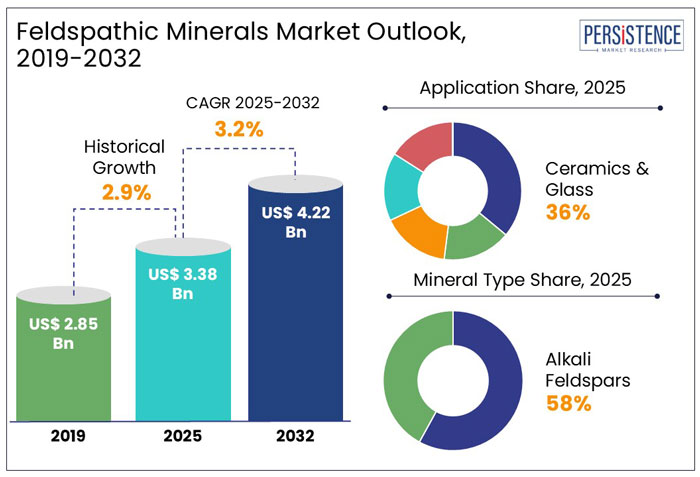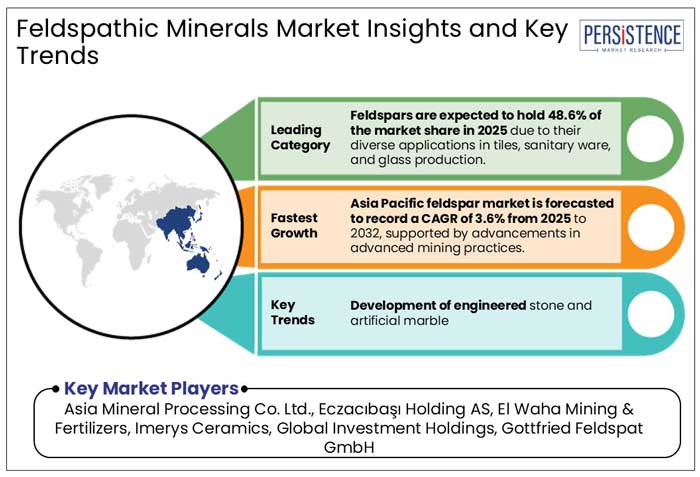Industry: Chemicals and Materials
Published Date: February-2025
Format: PPT*, PDF, EXCEL
Delivery Timelines: Contact Sales
Number of Pages: 197
Report ID: PMRREP35135
The global feldspathic minerals market size is anticipated to rise from US$ 3.38 Bn in 2025 to US$ 4.22 Bn by 2032. It is projected to witness a CAGR of 3.2% from 2025 to 2032.
The growing demand for feldspathic minerals fuels market expansion across the ceramic, construction, and enamel industries. Feldspar, a key raw material in porcelain, tiles, and glass manufacturing, is in high demand due to its fluxing properties, which enhance durability and aesthetics.
These countries are increasing production to meet rising global demand driven by urbanization and infrastructure development.
In addition, technical improvements in mineral processing and stronger environmental restrictions are anticipated to influence sustainable feldspar mining methods in the upcoming period.

Key Highlights of the Feldspathic Minerals Market
|
Global Market Attributes |
Key Insights |
|
Feldspathic Minerals Market Size (2025E) |
US$ 3.38 Bn |
|
Market Value Forecast (2032F) |
US$ 4.22 Bn |
|
Projected Growth (CAGR 2025 to 2032) |
3.2% |
|
Historical Market Growth (CAGR 2019 to 2024) |
2.9% |
Collaborative Initiatives Cultivate to Boost the Sustainable Mining Practices
The global feldspathic minerals industry witnessed a CAGR of 2.9% in the historical period between 2019 and 2024. Post-pandemic era offered innovative chances to develop environmentally friendly and sustainable mining technology to control the carbon footprint. Major players in the global industry developed several strategies to boost sustainable mining practices in the observed period.
For instance, Seitim is a joint venture between Imerys and Seitiss, a circular economy start-up, aiming to transform industrial waste into valuable mineral resources. The collaboration uses digital tools to identify waste sources and transform them into value-added products. Launched in 2023, Seitim is focusing on ceramic-like products and concrete production in Europe.
Major players such as Imerys plan to expand its partnerships with startups and universities to drive sustainability and circular economy practices in the upcoming period.
Government Regulation Supports Sustainable Mining to Boost Production through 2032
In the estimated timeframe from 2025 to 2032, the global demand for feldspathic mining is likely to showcase a CAGR of 3.2%. Governments throughout the world must adopt sustainable extraction methods to reduce the environmental effect of mining feldspathic minerals, which are essential for many sectors, due to strict regulations regarding the environment.
As industries adapt to green mining requirements, feldspathic mineral suppliers are investing in cleaner extraction and processing technologies.
Growth Drivers
Rising Construction Activities Boost Demand for Feldspathic Minerals
The construction industry has a substantial impact on the growth of the feldspar industry because it is widely utilized in tiles, glass, enamel, and ceramics for infrastructure projects that are driven by urbanization and population increase across the globe.
The U.S. construction industry is set to expand at a faster rate than China’s over the next 15 years, driven by government infrastructure investments and residential development projects.
In 2023, the Indian government allocated US$ 130 Bn to its National Infrastructure Pipeline, increasing demand for feldspar-based tiles, glass fibers, and enamel coatings.
As green building materials gain popularity, feldspar’s role in eco-friendly construction solutions is anticipated to fuel market expansion in the upcoming years.
Trend of Recycled Materials Affects the Production of Feldspar Reserves
Given that the glass and ceramics industries, which are significant feldspar consumers, are moving toward recycled materials to save costs and lessen their environmental effects, the rising trend of recycling end-use goods is anticipated to impede the expansion of the feldspar market.
Similarly, the ceramics industry is adopting recycled materials and industrial waste to meet sustainability goals and comply with strict environmental regulations. The European Union’s Circular Economy Action Plan (2020) promotes recycling in construction and manufacturing, impacting feldspar consumption.
As recycled substitutes become more efficient and cost-effective, the demand for freshly mined feldspar is expected to decline, potentially slowing industry expansion and reducing mineral production expenditures worldwide.
Engineered Stone and Artificial Marble Production Create New Application Avenues
The rise in engineered stone and artificial marble production is boosting the use of feldspar and other feldspathic minerals in construction, interior design, and infrastructure projects due to their durability, low maintenance, and aesthetic appeal.
The demand for artificial marble is increasing, in residential and commercial flooring, countertops, and wall cladding. In 2025, the demand for feldspathic minerals is expected to attain 36% in 2025 due to their diverse applications in ceramics and glass production, by Persistence Market Research.
Continuous improvements in the production of engineered stones are anticipated to help the feldspar sector by resulting in more industrial applications and environmentally friendly products.
Type Insights
Widespread Usage of Feldspar in Production Presents Novel Prospects
The feldspar segment is expected to grow with its widespread use in ceramics, glass manufacturing, and construction materials. In 2025, feldspars are projected to account for 48.6% of the market share due to their versatile applications in tiles, sanitary ware, and glass production.
Pegmatite, a coarse-grained feldspar-rich igneous rock, will hold 32.1% of the market share, used in specialized ceramics and high-purity quartz applications. Meanwhile, feldspathic sand, crucial for glassmaking and abrasives, is anticipated to capture 19.3% of the market.
In January 2024, Sibelco expanded its feldspar mining operations in Brazil and India, targeting increased supply for ceramics and electronics industries. With sustained demand for infrastructure and consumer goods, the feldspathic minerals market is poised for steady growth.

Stunning Appearance of Alkali Feldspars in Construction Shows Impressive Avenues
Alkali feldspars, which will account for 58% of the worldwide feldspathic minerals market in 2025, are becoming more prevalent in residential and commercial construction as appealing building stones and high-performance ceramic materials.
Orthoclase, sanidine, microcline, and anorthoclase are examples of alkali feldspars that are perfect for worktops, floors, and façade cladding because of their hardness, durability, and white streak appearance.
The trend of aesthetic interior design and eco-friendly materials supports demand. Microcline, the most common K-feldspar, forms at lower temperatures, making it a preferred mineral for durable ceramic and glass applications.
Plagioclase Feldspars, on the other hand, accounted for 42% of the market in 2025 and were mostly utilized as fluxing agents in metallurgy, abrasives, and glassmaking. In order to satisfy the growing demand for feldspathic materials globally, companies such as Sibelco and Quartz Corp are growing their mining operations.
Asia Pacific Prospers with High Feldspar Reserves in the Developing Countries
In 2025, Asia Pacific is projected to dominate the global feldspar market, accounting for 44% of the global market share, with its high feldspar mining production.
Asia Pacific feldspar market is forecasted to record a CAGR of 3.6% from 2025 to 2032, supported by advancements in advanced mining practices. The growing urban infrastructure development in countries like China, India, and Malaysia are fueling demand for feldspar as a key raw material in ceramic tile manufacturing.
According to the International Trade Administration, China remains the world’s largest construction market, projected to grow at an average annual rate of 8.6% from 2022 to 2030, with ceramic tiles being a crucial component of the expansion in the projected period.
Europe Gains Momentum with Significant Production of Feldspar
The market for feldspar minerals in Europe is gaining momentum, mainly due to increasing consumption in Italy, Spain, and Turkey.
Italy is the second-largest producer of feldspar, with strong demand driven by industries such as ceramics, glass, paints, and enamel. Meanwhile, Spain's market is expected to grow due to rising applications in construction, automotive, and glass manufacturing.
Turkey, with nearly 60 mining and metal industries and 4,500 mineral deposits, is a leading producer and exporter of feldspar, accounting for approximately 10% of the global reserve. This positive growth trend is anticipated to drive Europe's feldspar market throughout the forecast period.
Mining Operations in North America Rises with Presence of Market Players
North America's feldspar mining industry is steadily growing, especially in key mining regions such as Virginia, North Carolina, California, Oklahoma, Georgia, South Dakota, and Idaho.
North America is projected to account for a market share of 24% in the global feldspar market in 2025, as demand for the mineral rises in industries like glassmaking and ceramics.
Developments in the feldspar mineral market highlight a significant strategic partnership between two industry leaders, Sibelco and Imerys. Such collaboration aims to enhance their global presence and leverage each company's strengths to tap into new market opportunities.
Moreover, there is a growing emphasis among companies in the sector on adopting sustainable mining practices. This focus not only seeks to minimize environmental impact but also opens up new avenues for growth in the burgeoning sustainable feldspar market, reflecting a broader industry trend towards environmentally responsible operations.
Key Industry Developments
|
Report Attributes |
Details |
|
Historical Data/Actuals |
2019 - 2024 |
|
Forecast Period |
2025 - 2032 |
|
Market Analysis Units |
Value: US$ Bn/Mn, Volume: As applicable |
|
Geographical Coverage |
|
|
Segmental Coverage |
|
|
Competitive Analysis |
|
|
Report Highlights |
|
|
Customization and Pricing |
Available upon request |
By Type
By Mineral Type
By Application
By Region
To know more about delivery timeline for this report Contact Sales

The market is set to reach US$ 3.38 Bn in 2025.
In 2024, Turkey extracted 6.5 million metric tons, contributing to a global production of around 26 million tons.
Asia Mineral Processing Co. Ltd., Eczacıbaşı Holding AS, El Waha Mining & Fertilizers, and Imerys Ceramics are a few leading players.
The industry is estimated to rise at a CAGR of 3.2% through 2032.
Asia Pacific is projected to hold the largest share of the industry in 2025.